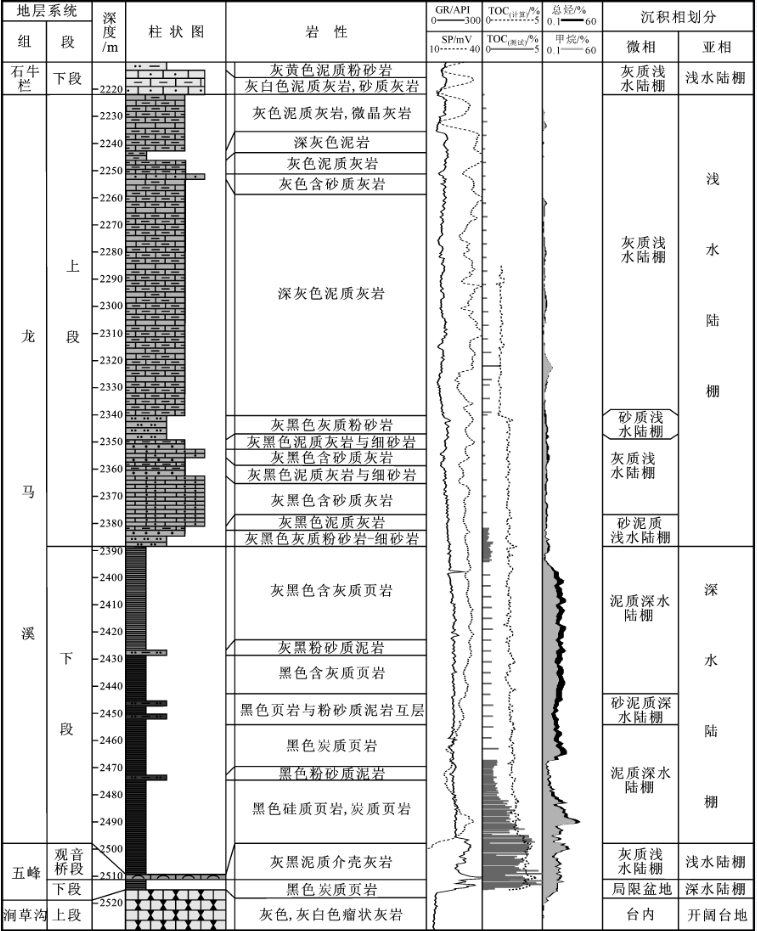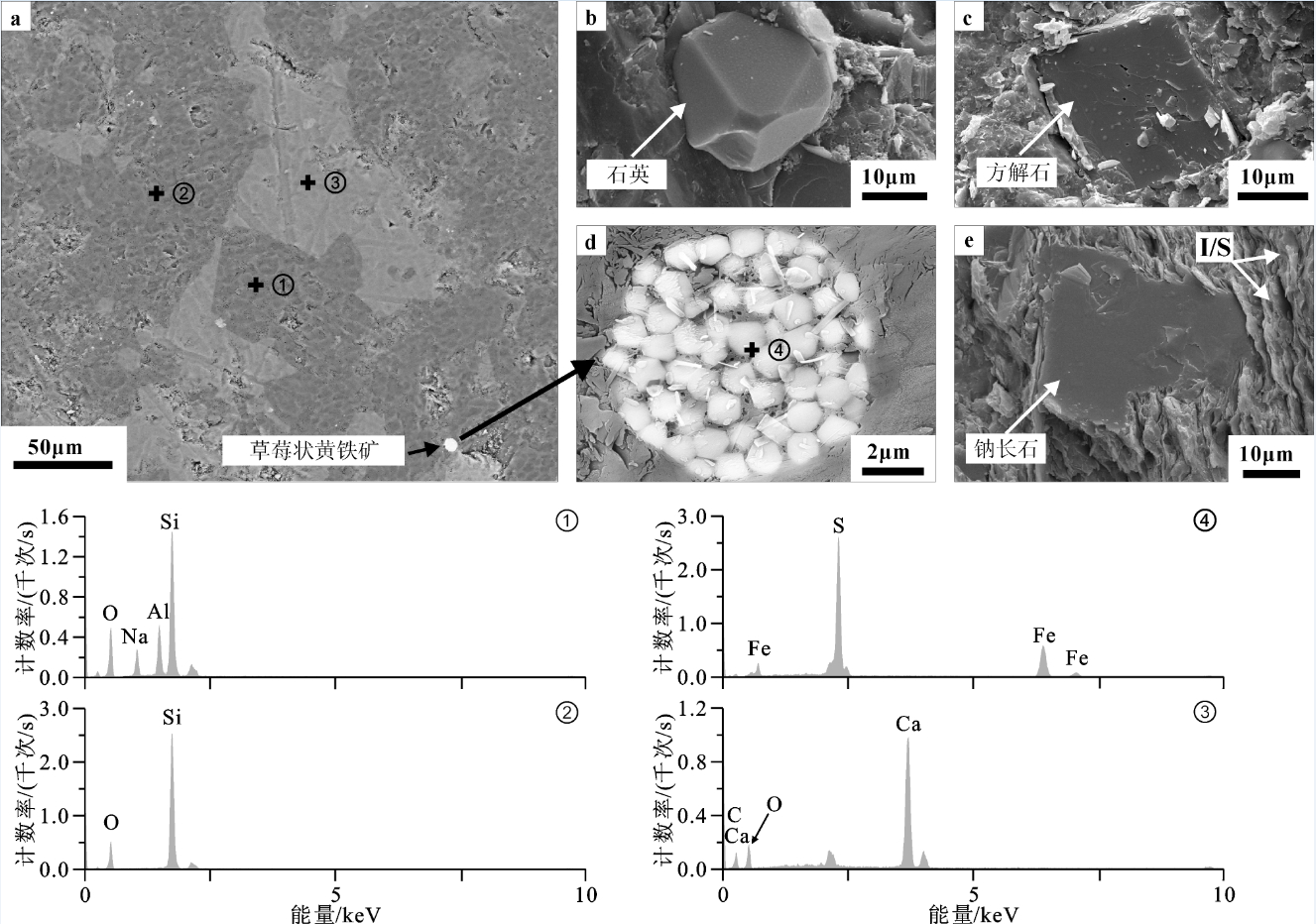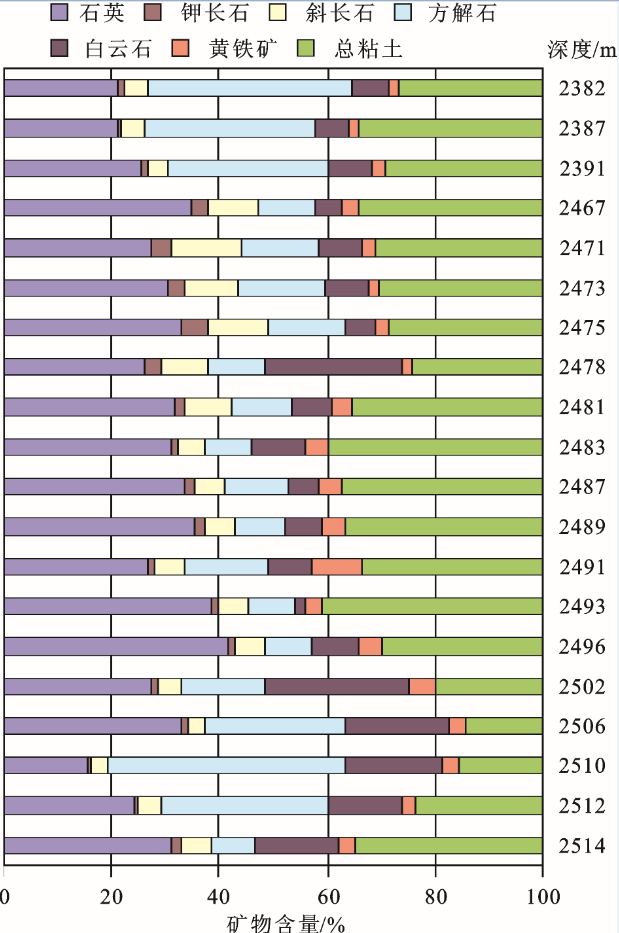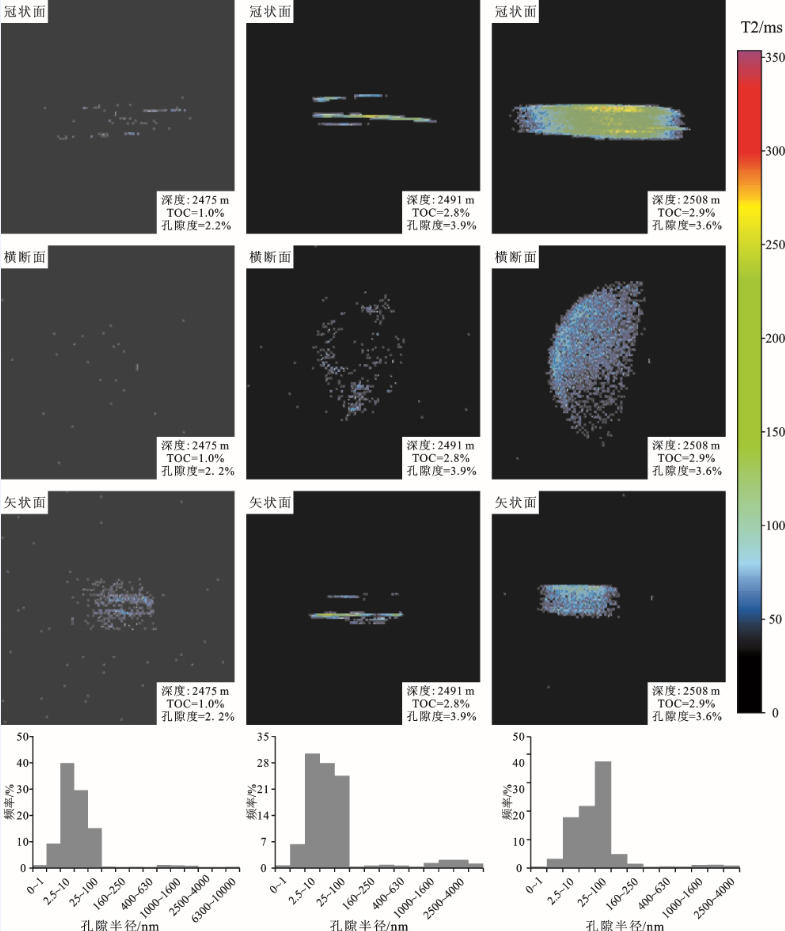Geological characteristics of Wufeng-Longmaxi shale-gas reservoir in the Huangjinba gas field, Zhaotong National Shale Gas Demonstration Area
-
摘要: 昭通国家级页岩气示范区黄金坝气田是继礁石坝和长宁-威远之后中国又一个在页岩气勘探、开发领域实现重大突破的地区,为了系统地展示黄金坝气田页岩气资源富集的储层条件,为未来的勘探工作提供参考,以五峰-龙马溪组页岩气储层为研究对象,从区域地质条件、储层岩石学、物性和地球化学4个方面对该页岩气储层进行了综合研究。结果表明稳定的区域构造和良好的顶底板条件是黄金坝地区页岩气资源富集的关键,良好的保存条件使储层维持了较高的压力(压力系数>1);较高的孔隙度(平均4%)和TOC含量(目的层>2%)提供了良好的储集空间,使储层具有较高的含气量(1.35~3.48 cm3/g,平均>2.50 cm3/g);天然气地球化学数据表明,区内天然气主要成分为CH4(>97%),其次还含有少量的C2H6、C3H8和CO2;天然气同位素数据表明烃类C同位素组成发生了倒转,表明储层具有良好的封闭性。但储层孔隙系统较为复杂,且非均质性极强,从而导致渗透率较低,在储层改造施工过程中应予以充分考虑。总体上,黄金坝气田具有较好的开发前景,生产测试表明,区内直井压裂产量为0.5×104~3.5×104 m3/d/井,水平井压裂产量可达12×104~40×104 m3/d/井。Abstract: Following Jiaoshiba and Changning-Weiyuan areas, Huangjinba shale gas field in Zhaotong National Shale Gas Demonstration Area is the place where the shale gas exploration and development have received a good achievement. To systemically demonstrate the reservoir conditions for shale gas accumulation in the Huangjinba shale gas field and provide a reference for future exploration, the authors studied the Wufeng-Longmaxi shale gas reservoir in detail in such aspects as regional geological setting, reservoir petrology, physical properties and geochemistry. The results indicate that the stable regional tectonics and well-developed roof and floor formations are crucial factors for shale gas enrichment in this region. These good preserving conditions help the reservoir maintain a high pressure (pressure coefficient >1). High porosity (mean=4%) and TOC content (target bed >2%) of the reservoir provide good spaces for hydrocarbons, and cause the reservoir rocks to have high gas values (1.35-3.48 cm3/g, >2.50 cm3/g on average). The geochemical data of natural gas show that the predominant composition is CH4(>97%), with minor compositions including C2H6, C3H8 and CO2. The isotopic data of natural gas show that the C isotopic constituents of hydrocarbons have been preserved, indicating that the reservoir is closed or semiclosed. Nevertheless, the pore system of the reservoir is very complicated and heterogeneous, which leads to the low permeability of the reservoir, and such a condition should be carefully treated during stimulation processes. In general, the shale gas development potential of the Huangjingba gas field is good, and the production test shows that the gas production quantity of fractured vertical well is 0.5×104-3.5×104 m3/day/well, and the quantity for fractured horizontal well is 12×104-40×104 m3/day/well.
-
-
图 1 研究区区域地质概况
a—扬子地台大地构造单元划分及研究区大地构造位置(据❶修改); A—扬子褶皱带; Ac—扬子盖层; Bi—印支旋回以来的盆地; By—燕山旋回 以来的盆地;W—五台褶皱带; Z—中条褶皱带; b—四川盆地及周缘五峰—龙马溪组页岩厚度等值线(据文献[10, 17]); c—黄金坝气田区域地质图(据❷修改; c中的点划线框为黄金坝气田的边界); 1—中侏罗统上沙溪庙组; 2—中侏罗统下沙溪庙组; 3—下侏罗 统自流井组; 4—上三叠统—下侏罗统香溪组; 5—中三叠统雷口坡组; 6—中三叠统嘉陵江组; 7—下三叠统飞仙关—铜街子组; 8—上二叠统乐 平组; 9—上二叠统峨眉山玄武岩; 10—下二叠统铜矿溪—栖霞—茅口组; 11—断层; 12—地层界线; 13—水系
Figure 1. Geological setting of the study area
a-Tectonic division of Yangtze Platform and tectonic location of the study area (modified after ①); A-Yangtze fold belt; Ac-Caprock of the Yangtze Platform; Bi-Basins since the Indosinian cycle; By-Basins since the Yanshanian cycle;W-Wutai fold belt; Z-Zhongtiao fold belt; b-Isopach of theWufeng—Longmaxi shale in the Sichuan Basin and its adjacent areas (after references [10, 17]); c-Regional geological setting of Huangjinba shale gas field (modified after ②; The dash line frame in c is the boundary of Huangjinba shale gas field); 1-Middle Jurassic Upper Shaximiao Formation; 2-Lower Jurassic Upper Shaximiao Formation; 3-Lower Jurassic Ziliujing Formation; 4- Upper Triassic—Lower Jurassic Xiangxi Formation; 5-Middle Triassic Leikoupo Formation; 6-Middle Triassic Jialingjiang Formation; 7-Lower Triassic Feixianguan—Tongjiezi Formation; 8-Upper Permian Leping Formation; 9-Upper Permian E’meishan basalt; 10-Lower Permian Tongkuangxi—Qixia—Maokou Formation; 11-Fault; 12-Boundary of strata; 13-River system
图 3 黄金坝页岩气储层主要矿物组成
a—五峰—龙马溪组黑色页岩基质矿物组成背散射电子图像(深灰色为硅酸盐矿物, 亮灰色为碳酸盐矿物, 白色亮点为金属矿物); b—页岩基质 中的自生石英; c—方解石自形晶; d—草莓状黄铁矿集合体; e—部分粘土矿化的钠长石颗粒及伊蒙混层矿物(I/S); ①~④为a和d 中黑十字处 的矿物化学组成能谱图
Figure 3. Main mineral composition of shale gas reservoir in Huangjinba shale gas field
a-Back scattering image of matrix minerals ofWufeng-Longmaxi black shale (e.g., dark gray particles are silicates, light grey particles are carbonates, and bright spots are metallic minerals); b-Althigenic quartz mineral in shale matrix; c-Euhedral calcite crystal in shale matrix; d-Pyrite framboid; e-Partly argillized albite particle and mixed-layer minerals of illite and smectite (I/S); ①-④ are energy dispersive spectra of the cross
表 1 黄金坝气田储层含气性及天然气地球化学特征
Table 1 Gas content and geochemical characteristics of natural gas in the Huangjinba shale gas feild
深度/m 含气量/(cm3/g) CO2/% CH4/% C2H6/% C3H8/% δ13CV-PDB/‰ CO2 CH4 C2H6 C3H8 2384 1.43 0.33 97.76 1.83 0.08 -13.9 -27.9 -29.3 -32.9 2393 1.35 0.14 97.59 2.16 0.10 nd. -24.3 -31.1 -32.5 2470 2.46 0.15 97.68 1.99 0.18 -9.7 -25.9 -30.4 -27.8 2475 2.28 0.28 97.72 1.89 0.12 -8.3 -21.6 -30.6 -28.1 2480 2.32 0.32 97.93 1.59 0.16 -7.6 -20.8 -29.7 -28.7 2485 2.78 0.17 97.97 1.77 0.09 nd. -22.7 -31.3 nd. 2490 3.26 0.26 98.24 1.40 0.10 -8.1 -23.6 -31.6 nd. 2497 3.42 0.35 97.52 2.01 0.12 -8.1 -24 -31.5 -28.8 2506 2.86 0.40 98.74 0.68 0.17 -5.1 -21.4 -30.5 -28 2513 3.48 0.38 98.40 1.04 0.18 -7.3 -23.5 -31.8 -28.2 注:"nd."表示数据未检出 表 2 美国和中国页岩气储层的基本特征
Table 2 Basic properties of gas shale reservoirs in the United States and China
页岩气区 埋深/m 厚度/m TOC/% Ro/% 孔隙度/% 吸附气/% 含气量/(m3/t) 产量/(104m3/d/井) 黄金坝 2390~2516 32~40 0.6~6.5 2.8~3.0 1.0-7.0 49~82 1.35-3.48 nd. 樵石坝 2313~2595 38-42 3.5 2.2-3.1 1.2-7.2 35~47 0.44-5.19 >6.00 Antrim 183~732 21~37 0.3-24 0.4~0.6 9.0 70 1.1-2.8 0.11-1.42 Ohio 610~1524 9~30 0-4.7 0.4-1.3 4.7 50 1.7~2.8 0.17-0.28 New Albany 183~1494 15~30 1~25 0.4~1.0 10~14 40~60 1.1-2.3 0.11-0.23 Barnett 1981~2591 15~61 4.5 0.5~2.0 4~5 35~50 8.5~9.9 0.85-0.99 Lewis 914~1829 61~91 0.45-2.5 1.6-1.88 3-5.3 60~85 0.4-1.3 0.04-0.13 Marcellus 1219~2591 15~61 3~12 0.4-1.3 10.0 nd. 1.7~2.8 8.78 Woodford 1829~3353 37~67 1~14 1.1-3.0 3~9 nd. 5.7~8.5 1.18 注:礁石坝页岩气田的数据引自文献[10]; Antrim, Ohio, New Albany, Barnett,和Lewis页岩的数据引自文献[25]; Marcellus和Woodford页岩的数据引自文献[36]; Barnett页岩的吸附气含量数据引自文献[26]; “nd.”表示数据未获取。 -
[1] NETL. Modern Shale Gas Development in the United States:An Update[R]. National Energy Technology Laboratory, U.S. Department of Energy, 2013, 79.
[2] BP PLC. Statistical, Review of World Energy 2014[R]. London, UK, BP PLC, 2012.
[3] 李君臣, 董秀成, 高建. 我国天然气消费的系统动力学预测与分析[J]. 天然气工业, 2010, 30(4):127-129. Li Juncheng, Dong Xiucheng, Gao Jian. Dynamical modeling of natural gas consumption in China[J]. Natural Gas Industry, 2010, 30(4):127-129(in Chinese with English abstract). [4] 邹才能, 董大忠, 王社教, 等. 中国页岩气形成机理、地质特征及资源潜力[J]. 石油勘探与开发, 2010, 37(6):641-653. Zou Caineng, Dong Dazhong, Wang Shejiao, et al. Geological characteristics, formation mechanism and resource potential of shale gas in China[J]. Petroleum Exploration and Development, 2010, 37(6):641-653(in Chinese with English abstract). [5] 周守为, 姜伟, 张春阳, 等. 美国Eagle Ford页岩气开发对我国页岩气勘探开发的启示[J]. 中国工程科学, 2012, 14(6):16-21. Zhou Shouwei, Jiang Wei, Zhang Chunyang, et al. The enlightenment on shale gas exploration and development in China getting from Eagle Ford in America[J]. Engineering Sciences, 2012, 14(6):16-21(in Chinese with English abstract). [6] 张金川, 聂海宽, 徐波, 等. 四川盆地页岩气成藏地质条件[J]. 天然气工业, 2008, 28(2):151-156. Zhang Jinchuan, Nie Haikuan, Xu Bo, et al. Geological condition of shale gas accumulation in Sichuan Basin[J]. Natural Gas Industry, 2008, 28(2):151-156(in Chinese with English abstract). [7] 张春明, 张维生, 郭英海. 川东南-黔北地区龙马溪组沉积环境及对烃源岩的影响[J]. 地学前缘, 2012, 1(1):136-145. Zhang Chunming, Zhang Weisheng, Guo Yinghai. Sedimentary environment and its effect on hydrocarbon source rocks of Longmaxi Formation in southeast Sichuan and northern Guizhou[J]. Earth Science Frontiers, 2012, 1(1):136-145(in Chinese with English abstract) [8] 梁超, 姜在兴, 杨镱婷, 等. 四川盆地五峰组-龙马溪组页岩岩相及储集空间特征[J]. 石油勘探与开发, 2012, 39(6):691-698. Liang Chao, Jiang Zaixing, Yang Yiting, et al. Characteristics of shale lithofacies and reservoir space of the Wufeng-Longmaxi Formation, Sichuan Basin[J]. Petroleum Exploration and Development, 2012, 39(6):691-698(in Chinese with English abstract). [9] Guo T. Evaluation of highly thermally mature shale gas reservoirs in complex structural parts of the Sichuan Basin[J]. Journal of Earth Science, 2013, 24(6):863-873.
[10] 郭彤楼, 张汉荣. 四川盆地焦石坝页岩气田形成与富集高产模式[J]. 石油勘探与开发, 2014, 41(1):28-36. Guo Tonglou, Zhang Hanrong. Formation and enrichment mode of Jiaoshiba shale gas field, Sichuan Basin[J]. Petroleum Exploration and Development, 2014, 41(1):28-36(in Chinese with English abstract). [11] 黄羚, 徐政语, 王鹏万, 等. 桂中坳陷上古生界页岩气资源潜力分析[J]. 中国地质, 2012, 39(2):497-506. Huang Ling, Xu Zhengyu, Wang Pengwan, et al. An analysis of resource potential of Upper Paleozoic shale gas in Guizhong depression[J]. Geology in China, 2012, 39(2):497-506(in Chinese with English abstract). [12] 汪凯明. 桂中坳陷泥盆系页岩气成藏条件浅析[J]. 中国地质, 2013, 40(2):430-438. Wang Kaiming. Shale gas accumulation conditions of Devonian strata in Guizhong depression[J]. Geology in China, 2013, 40(2):430-438(in Chinese with English abstract). [13] 滕吉文, 刘有山. 中国页岩气成藏和潜在产能与对环境的污染分析[J]. 中国地质, 2013, 40(1):1-30. Teng Jiwen, Liu Youshan. An analysis of reservoir formation, potential productivity and environmental pollution effect of shale gas in China[J]. Geology in China, 2013, 40(1):1-30(in Chinese with English abstract). [14] 邱小松, 胡明毅, 胡忠贵, 等. 页岩气资源评价方法及评价参数赋值——以中扬子地区五峰组-龙马溪组为例[J]. 中国地质, 2014, 41(6):2091-2098. Qiu Xiaosong, Hu Mingyi, Hu Zhonggui, et al. Evaluation methods and parameter assignments of shale gas resources:A case study of the Wufeng-Longmaxi Formation in the Middle Yangtze region[J]. Geology in China, 2014, 41(6):2091-2098(in Chinese with English abstract). [15] 郭彤楼, 刘若冰. 复杂构造区高演化程度海相页岩气勘探突破的启示——以四川盆地东部盆缘YJ1井为例[J]. 天然气地球科学, 2013, 24(4):643-651. Guo Tonglou, Liu Ruobing. Implication from marine shale gas exploration breakthrough in complicated structural area at high thermal stage:Taking Longmaxi formation in well JY1 as an example[J]. Natural Gas Geoscience, 2013, 24(4):643-651(in Chinese with English abstract). [16] 郭旭升, 胡东风, 文治东, 等. 四川盆地及周缘下古生界海相页岩气富集高产主控因素——以焦石坝地区五峰组-龙马溪组为例[J]. 中国地质, 2014, 41(3):893-901. Guo Xusheng, Hu Dongfeng, Wen Zhidong, et al. Major factors controlling the accumulation and high productivity in marine shale gas in the Lower Paleozoic of Sichuan Basin and its periphery:A case study of the Wufeng-Longmaxi Formation of Jiaoshiba area[J]. Geology in China, 2014, 41(3):893-901(in Chinese with English abstract). [17] 曾祥亮, 刘树根, 黄文明, 等. 四川盆地志留系龙马溪组页岩与美国Fort Worth盆地石炭系Barnett组页岩地质特征对比[J]. 地质通报, 2011, 30(2/3):372-384. Zeng Xiangliang, Liu Shugen, Huang Wenming, et al. Comparison of Silurian Longmaxi Formation shale of Sichuan Basin in China and Carboniferous Barnett Formation shale of Fort Worth Basin in United States[J]. Geological Bulletin of China, 2011, 30(2/3):372-384(in Chinese with English abstract). [18] 翟光明, 宋建国, 靳久强, 等. 板块构造演化与含油气盆地形成与评价[M]. 北京:石油工业出版社, 2002:260-276. Zhai Guangming, Song Jianguo, Jin Yongqiang, et al. Plate Tectonic Evolution and Formation and Evaluation of Petroleumbearing Basins[M]. Beijing:Petroleum Industry Press, 2002:260-276(in Chinese). [19] Su W, Huff W D, Ettensohn F R, et al. K-bentonite, black-shale and flysch successions at the Ordovician-Silurian transition, South China:Possible sedimentary responses to the accretion of Cathaysia to the Yangtze Block and its implications for the evolution of Gondwana[J]. Gondwana Research, 2009, 15:111-130.
[20] Haq B U, Schutter S R. A chronology of Paleozoic sea-level changes[J]. Science, 2008, 322(3):64-67.
[21] 聂瑞贞. 黔中隆起及其周缘奥陶系层序地层格架及古地理演化[D]. 北京:中国地质大学, 2006:23-39. Nie Ruizhen. Sequance-stratigraphic Framework and Its Palaeogeographical Background for Ordovician System of the Central Guizhou Uplift and Its Adjacent Areas[D]. Beijing:China University of Geosciences, 2006:23-39(in Chinese with English abstract). [22] Delabroye A, Vecoli M. The end-Ordovician glaciation and the Hirnantian Stage:A global review and questions about Late Ordovician event stratigraphy[J]. Earth Science Reviews, 2010, 98:269-282.
[23] Ross D J K, Bustin R M. The importance of shale composition and pore structure upon gas storage potential of shale gas reservoirs[J]. Marine and Petroleum Geology, 2009, 26:916-927.
[24] Bernard S, Wirth R, Schreiber A, et al. Formation of nanoporous pyrobitumen residues during maturation of the Barnett Shale (Fort Worth Basin)[J]. International Journal of Coal Geology, 2012, 103:3-11.
[25] Curtis J B. Fractured Shale Gas Systems[J]. AAPG Bulletin, 2002, 86(11):1921-1938.
[26] Montgomery S L, Jarvie D M, Bowker K A, et al. Mississippian Barnett Shale, Fort Worth basin, north-central Texas:Gas-shale play with multi-trillion cubic foot potential[J]. AAPG Bulletin, 2005, 89(2):155-175.
[27] Chalmers G R, Bustin R M, Power I M. Characterization of gas shale pore systems by porosimetry, pycnometry, surface area, and field emission scanning electron microscopy/transmission electron microscopy image analyses:Examples from the Barnett, Woodford, Haynesville, Marcellus, and Doig units[J]. AAPG Bulletin, 2012, 96(6):1099-1119.
[28] Cao T, Song Z, Wang S, et al. Characterizing the pore structure in the Silurian and Permian shales of the Sichuan Basin, China[J]. Marine and Petroleum Geology, 2015, 61:140-150.
[29] Tang X, Jiang Z, Li Z, et al. The effect of the variation in material composition on the heterogeneous pore structure of highmaturity shale of the Silurian Longmaxi formation in the southeastern Sichuan Basin, China[J]. Journal of Natural Gas Science and Engineering, 2015, 23:464-473.
[30] Labani M M, Rezaee R, Saeedi A, et al. Evaluation of pore size spectrum of gas shale reservoirs using low pressure nitrogen adsorption, gas expansion and mercury porosimetry:A case study from the Perth and Canning Basins, Western Australia[J]. Journal of Petroleum Science and Engineering, 2013, 112:7-16.
[31] Loucks R G, Reed R M, Ruppel S C, et al. Morphology, genesis, and distribution of nanometer-scale pores in siliceous mudstones of the Mississippian Barnett shale[J]. Journal of Sedimentary Research, 2009, 79:848-861.
[32] Robert L, Burwell J R. Physical chemistry division commission on colloid and surface chemistry definitions, terminology and symbols in colloid and surface chemistry part Ⅱ:Heterogeneous catalysis (rules approved 1975)[J]. Pure and Applied Chemistry, 1976, 46:71-90.
[33] Hao F, Zou H, Lu Y. Mechanisms of shale gas storage:Implications for shale gas exploration in China[J]. AAPG Bulletin, 2013, 97(8):1325-1346.
[34] Tilley B, McLellan S, Hiebert S, et al. Gas isotope reversals in fractured gas reservoirs of the western Canadian Foothills:Mature shale gases in disguise[J]. AAPG Bulletin, 2011, 95:1399-1422.
[35] 刘树根. 四川盆地下组合油气成藏机理研究[R]. 成都:中国石化勘探南方分公司, 2009. Liu Shugen. The Oil and Gas Formation Mechanism of the Lower Paleozoic in Sichuan Basin[R]. Chengdu:Exploration Southern Company, SINOPEC, 2009(in Chinese). [36] Arthur J D, Langhus B, Alleman D. An Overview of Modern Shale Gas Development in the United States[R]. ALL Consulting, 2008, 21. http://www.all-llc.com/publicdownloads/ALLShaleOverviewFINAL.pdf.



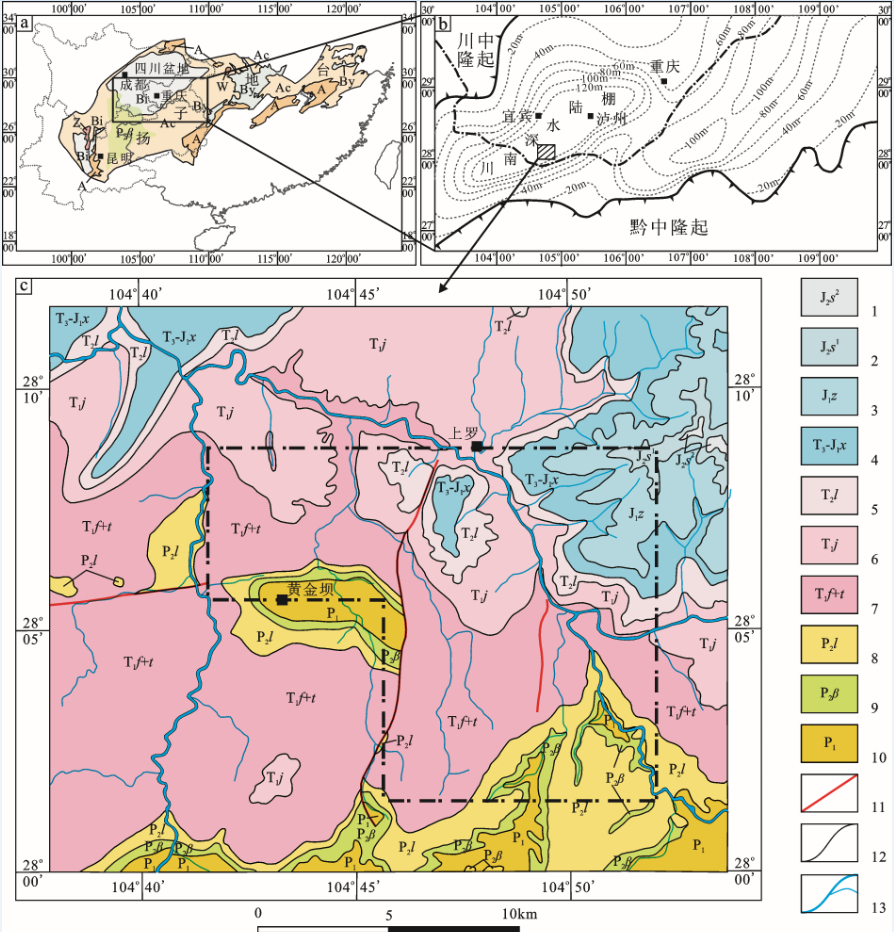
 下载:
下载:
